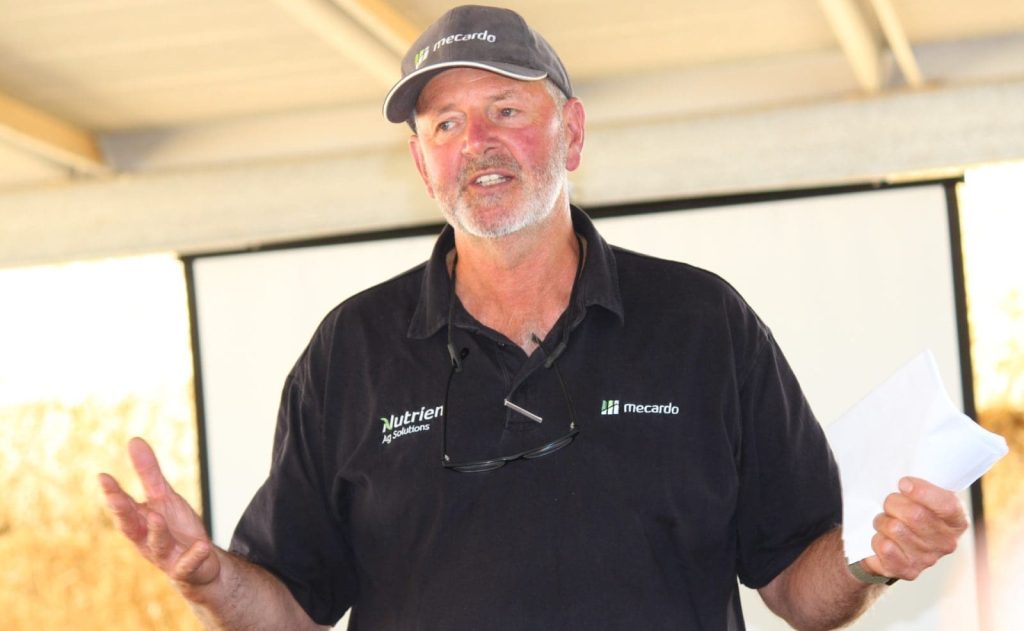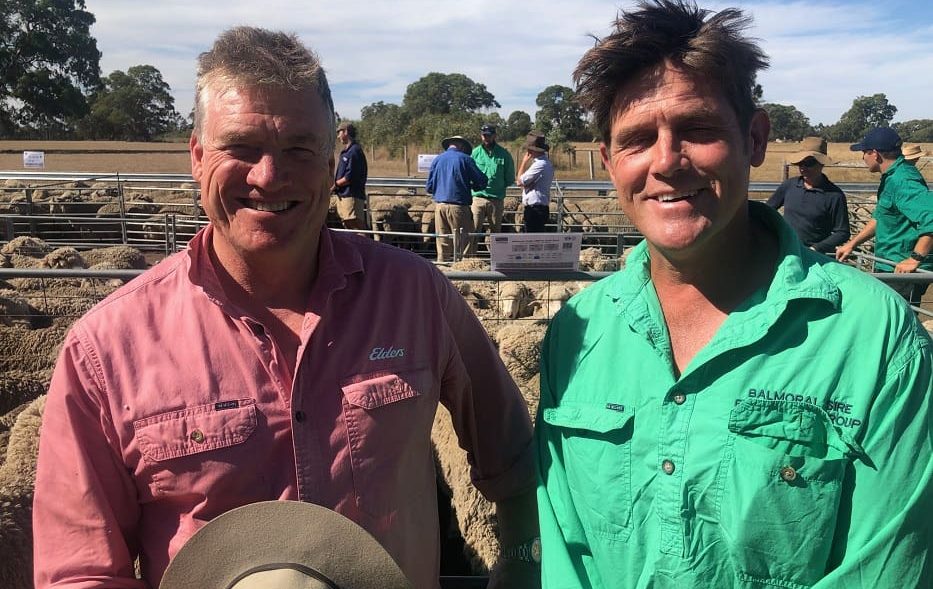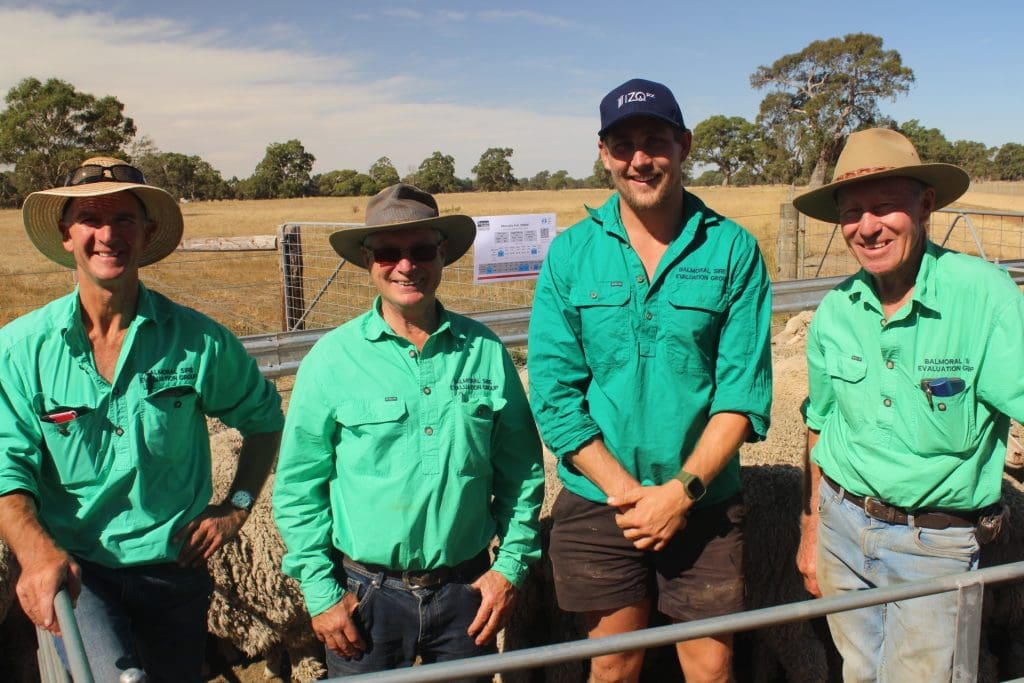
Mecardo analyst Robert Herrmann at the Balmoral Breeders field day at Tarranlea.
AUSTRALIA’s Merino sheep industry needs to demonstrate continuous improvement to regain the acres lost to cropping and other commodities, growers were told at a Balmoral Breeders sire evaluation field day at Tarranlea in western Victoria on Friday.
Industry analyst Robert Herrmann said Australia had gone from 170 million sheep with 90 percent of it wool to less than 80 million sheep and less than 80pc of it wool
“That’s what we’re confronting.
“To turn it around it’s not about you blokes doing great sire work, that’s part of it, it’s about the rest of Australia knowing how good the Merinos are and what they can do.”
the Merino sheep is now at its peak in terms of performance with the sector’s belated engagement with science – through performance recording and benchmarking putting the industry’s rate of improvement at similar levels to competitor industries.
“It produces wool and meat sustainably and is meeting the requirements of a growing global population,” he said.
“Programs like the Balmoral sire evaluation project have contributed along with others.
“In the future though, this banked improvement will not be enough; the industry will need to demonstrate continuous improvement – no different from any other industry or business intent on staying relevant,” he said.
“We will need to continue to research and develop the next advancements and extend them to the rank and file producers for uptake.”
Everyone needs to sing from the same hymn sheet
Mr Herrmann said the Merino industry also needs a cohesive story and “everyone singing from the same hymn sheet to espouse the value of the Merino.”
“And finally, we need to tell the story.
“We need to tell it in a way that is compelling, becoming ‘raving fans’ be prepared to argue strongly for the industry we all love. Build the supporter base and number of broadacre farmers producing Merino wool,” he said.
“If we continue to improve the Merino and our industry, if we present a cohesive story and we actively promote the industry then we will be the generation that ‘made Merino great again’.”
Mr Herrmann said saying that “cropping is prescription farming based on science, so it is easier to take everyone along for the journey” is a “cop-out” used in the Merino industry for too long.
“We need to focus on measurements improvements and then disseminate the improvements across the industry, have a sound story and then prosecute it widely.
“It’s not the studs that are going to do it anymore, it is the grassroots producers who are doing this science work that you are doing here – but have a look how many are here?”
BCG credited with good advocacy and story-telling
In his presentation, Mr Herrmann said WoolProducers Australia’s ‘Trust in Australian Wool’ program and the Australian Wool Traceability Hub initiative will over time translate to value for the sector. He highlighted the Birchip Cropping Group as a good example of advocacy and story telling.
“They constantly advocate for new technologies and science-based research and trials.
“BCG’s research and communication activities provide evidence, support and tools for improving farm, management practices and profitability,” he said.
“They are so good at what they do and everybody hands on what they say – and not only producers, but government and industry.”
But Mr Herrmann hesitated when asked if wool levy monies should be directed toward BCG, but he said funds needed to focus on why there has been a decline in sheep numbers.
Mr Herrmann said most of the ag college graduates he talks to intend to pursue cropping after graduation.
“It could be a result of the diesel they put on their Corn Flakes at Marcus Oldham, or more likely it is because the grain and oilseed industry presents as an exciting career using science and data to identify future productivity improvements and enhancements.”
Mr Herrmann said the future positioning of Australian commodities on the global stage and while wool can benefit from its niche product status, markets need sufficient and reliable supply otherwise substitutes take over. He said the long-term decline in wool production impacts directly on funding for research, development and marketing.
“And to fund future R&D investment, the wool clip needs to grow in value.”
Is an AWI extension program needed?
When asked what is the lowest hanging fruit for the industry, Mr Herrmann said suggested Australian Wool Innovation fund an extension program to push out to growers the messages being extended to the “true believers” at the Balmoral Breeders field day.
“And explain to them why they should be considering introducing Merino sheep back into their operations.”
Mr Herrmann said Australian wool was once 4-5pc of the world apparel market, but is less than one percent now.
“There is a heap of room out there for wool”, but mills would find alternative fibre sources if wool was not available, he said.
Mr Herrmann argued that Australia cannot oversupply its agricultural commodity markets, including sheep meat and wool.
When it was suggested that producers have left the wool industry because buyers were not paying enough, Mr Herrmann said benchmarking data showed that farmers have not gone into cropping because they were going to make more money.
“Benchmarking tells you that there is no difference (between wool and cropping) over time.”
Harrow grower Michael Craig said the industry not been able to mechanise sufficiently and another grower said sheep are labour intensive.
Merinos and mulesing

Elders district wool manager Andrew Howells, left, with Harrow grower Michael Craig at Australia Park at Tarranlea.
Coleraine district producer Peter Small said there was a premium for certified non-mulesed wool and a discount for wool from mulesed sheep.
“You need to go out and tell the industry if they want to get the real price of wool they need to present non-mulesed wool.”
Mr Craig asked isn’t it best not to talk about mulesing.
“I think our industry has found the right spot – we just don’t talk about that.”
Several growers at the day indicated they were producing non-mulesed wool and another producer said she was working toward a non-mulesed flock. But there was a perception that crossbreds made more money and “if you are on Merinos it’s bloody hard work and you are not making as much money,” she said.
Difference in levy bodies to become an issue
Culla Merino breeder Anthony Close said with AWI focusing on wool and Meat & Livestock Australia dealing with sheep meat there was not a single focus body for sheep producers.
“We (crossbred and Merino producers) are all sheep producers, we are all one animal really, yet we’ve got such a difference in levy bodies.”
Mr Herrman said that question will become more of an issue in coming years.
“Because for a start, the wool levy funding is not what it was … but at the end of the day … if we can’t present an attractive option to people as Merino breeders then they’ve got alternatives, they’ve got other options and we have to recognize that.
“That’s the reality of where we’ve come from since the 1990s, people have taken other options,” he said.
“Why have they done it? I don’t accept that they went to one other enterprise because there was more money – the benchmarking will tell you that over time, a good well-run self-replacing Merino flock stacks up.”

At the Balmoral Breeders field day, from left, Mark Bunge, Tom Silcock, Rocky Luhrs and Hugh Jarvis.

I find Robert Herrmann’s comments patronising and at best ignorant.
Put simply, if we growers are to get better returns and therefore AWI gets a better income stream, AWI has to market our wool much better.
For Herrmann to say that we the growers should advocate more is a joke. We grow the product and then we pay via levies to have AWI market the wool.
Look very hard at AWI’s marketing strategy. Or the lack of it!
Why have the countless millions of dollars that wool growers have contributed to AWC and AWI not produced results?
Mr Herrmann obviously has no idea of the challenges we face maintaining wool-growing sheep in the pastoral areas.
David, the whole industry is frustrated with AWI and all the wool bodies that preceded it. Don’t kick Robert Herrmann; he has no more power than you or me. AWI is an industry problem; our problem. It’s our leaders who we must motivate; but where do we find them? Where are they?